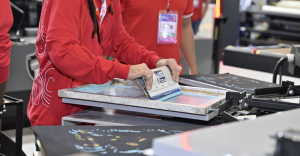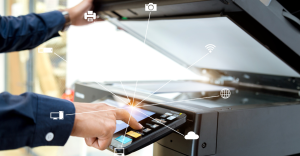Those who work in the field know that high-volume graphic printing depends on the use of modern machinery and increasingly faster and more flexible techniques. Flexography stands out in this context.
Widely used in the printing of packaging and labels, the technique works much like a “stamp”. In it, only the embossed areas receive ink, the others, being lower, are not printed.
Would you like to know more about this technique and its main advantages? Follow the article.
What is flexography?
Flexography is a direct and rotary printing system that uses embossed printing plates. They receive ink and transfer it to the surface to be printed, always in the appropriate amount.
In the transfer there is the use of a plate that contains the design to be printed, known as the flexographic plate.
For simplicity, imagine using a stamp to transfer the design of a logo onto paper. The concept is the same!
The difference is that paper is replaced by flexible packaging, cardboard, or even coating ceramics or techniques.
How does flexographic printing work?
The flexographic printing process involves several steps. But before knowing what they are, we invite you to know the most suitable equipment:
- Ink: used to give the desired color to the drawing;
- Anilox cylinder: represented by a cylinder with microholes that collect the ink in the tank and transfer it, in the ideal amount, to the plate;
- Rollers: adopted to hold the cliché plate, used to transfer the printing art;
- Plate: contains the drawing of what will be printed.
On the basis of this equipment, the processes are carried out in the following order:
- Creation of the cliché: the image to be printed is transferred to a flexible plate, forming the relief;
- Inking: the ink is applied to the highest points of the cliché;
- Printing: the cliché comes into contact with the material to be printed, transferring the ink;
- Drying: the ink dries quickly, allowing the process to continue.
It is important to note that the cliché, which is responsible for transferring the ink to the product, must be properly fixed to the roller. In this way, the printing is done in the best possible way and with the fewest possible errors.
Advantages of flexography
Flexography gets its name because it is based on the printing of several types of flexible materials, such as plastics, paper, corrugated cardboard and aluminum.
This technique is also about 100 years old! It was developed at the beginning of the 20th century by the machine manufacturers Holweg, Windmoller & Holscher and Fischer & Krecke.
These specialists developed new elements such as inks, parts and, one of the main products for the origin of flexography, the photopolymer.
Since then, the technique has been improved and its advantages and benefits have increased.
Below are some of the most important possibilities created by the use of flexography:
Good print quality
Flexography is the most efficient process in label production, especially in the light of technological innovations and the digitalization of printing plates.
Flexography promotes optimal print quality, with extremely high levels of resolution and linearity.
It also allows you to print special effects with metallic or even fluorescent inks.
Cost Reduction
By eliminating the need for cylinders, the cost of flexography is much lower.
The use of flexible photopolymers or elastomers eliminates the need for cylinders. In addition to making these materials more accessible, the cost of labels, tags, and packaging is reduced and their quality is improved.
Waste reduction.
With this technology, it is possible to determine the amount of ink that will be used during the printing process, making the process more predictable and assertive.
As a result, costs are more competitive and waste and excessive ink usage are reduced.
Minimum quantity flexibility
The evolution of technology also promotes greater flexibility in the minimum quantity required.
Because the cost of engraving is lower and color correction is faster, design changes can be made without a major impact on the final order value.
As a result, flexography is very competitive in the short and medium runs that are the reality of today’s marketplace.
Flexography requires care
The most important part of flexography is the cliché plate. It is responsible for transferring the design to the product.
Therefore, if a plate is damaged or used improperly, the printing can be compromised and, in many cases, the entire process can be rendered inoperable.
It is therefore necessary to take the utmost care when mounting the plate on its support.
It is essential to avoid bubbles or even a detachment of the transfer roller. In this way, the quality of the print is maintained at the highest possible speed.
The use of high quality mounting tapes is a good indication in this regard. These items should allow the cliché to be properly adhered to the roll.
They must also be able to withstand the high printing speed to prevent the cliché edges from peeling.
In addition to increasing the life and adhesion of the plate to the roll, the tapes reduce plate squeezing, which facilitates ink transfer and reduces potential printing problems.
Why is flexography so popular?
As you have seen, flexography stands out for its versatility and ability to print at high speeds, making it ideal for mass production of packaging and other materials.
In addition, the technique has a number of applications:
- Miscellaneous packaging: cardboard boxes, plastic bags, labels, flexible packaging;
- Promotional materials: stickers, banners, posters;
- Toiletries: packaging for soaps, shampoos, etc.
- Food industry: manufacture of packaging for various processed foods.
Last but not least, the quality of the images and the possibility of using environmentally friendly inks are factors that contribute to its growing demand in the graphics market.




